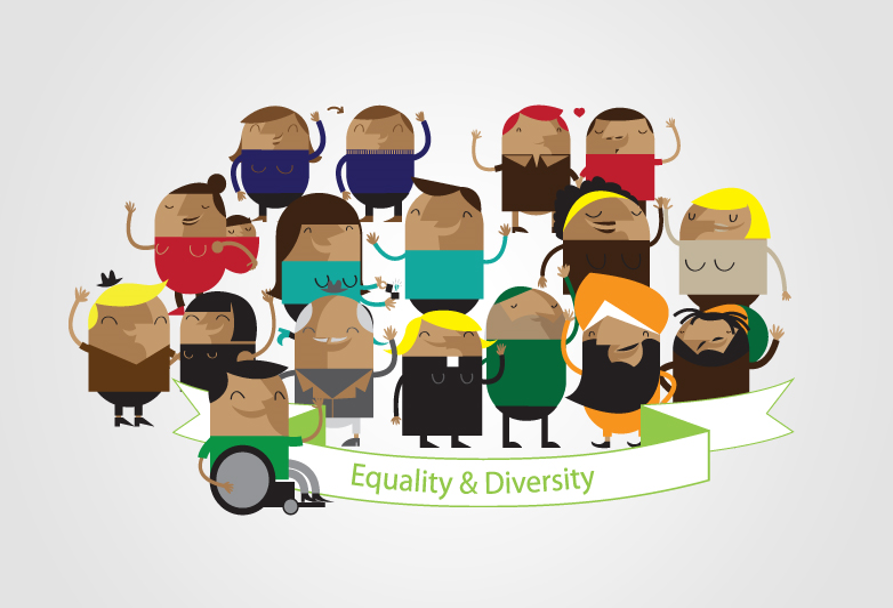Are you doing all you can to ensure that you promote diversity and equality in your workplace? Most employers are keen to play their part in ensuring that everyone has a fair and equal chance, and can recognise the benefits of ensuring that their business really delivers when it comes to such provisions and initiatives.
The problem is though, there is a lot of information out there that you might have come across that isn’t entirely accurate. As is the case when you’re dealing with the complexities of human behaviour, as well as the intricacies of the law, things can become a little complicated, and it can be hard to work out exactly what your responsibilities are.
All too often, there are some common myths and misconceptions that can actually hold you back from creating exemplary practices. We want to ensure that you don’t fall into this trap.
Before we get into anything else, it’s worthwhile to consider what we’re actually dealing with here.
Though ‘equality’ and ‘diversity’ are often used interchangeably, they don’t actually have the same meaning.
Equality is about ‘creating a fairer society, where everyone can participate and has the opportunity to fulfil their potential’ (Department of Health, 2004).
Diversity means difference. In this context, it’s about recognising individual and group differences within the workplace, and ensuring that everyone’s needs and requirements are understood and met.
If you’re passionate about getting things right, then first of all you need to recognise the mistakes that you might be making. The most common cause for this is having the wrong information. Read on to find out more about the myths and misconceptions about diversity and equality at work.
Myth 1 – You have to treat everyone the same
It’s a very common misconception that to promote diversity and equality in your workplace, you simply have to treat everyone the same. After all, this seems like a common sense approach. Every employee, regardless of their age, gender, sexual orientation, religious beliefs, race, and so on, simply gets the same treatment, and that makes everything fair and equal.
It doesn’t quite work this way though. Sometimes, by treating everyone equally, you’re actually accidentally discriminating against certain groups. Let’s consider an example to demonstrate the point.
Suppose that your business has created shift patterns that require workers to start at 7am. You may have an employee with a certain disability that is worse first thing on a morning, and they may require a little extra time to get ready. They may have to take medications, for example, before they’re able to face the day.
In this situation, it would be reasonable to give them a slightly later starting time. In fact, if you want to ensure that they’re treated equally, it would be essential.
This doesn’t mean that they have ‘extra privileges’. You’re simply giving them the opportunity they need to perform and excel in their role.
It’s not about compromising business needs. It’s simply about taking a flexible approach, and recognising that a one-size-fits-all approach often isn’t fit for purpose.
To treat individuals as equals, you will sometimes have to accommodate their differences. Rather than processes, it’s about outcomes.
Myth 2 – There’s never any return on this kind of investment
It’s true that if you want to get things right when it comes to your diversity and equality practices, it’s likely that you’ll have to invest time and money. The exact amounts will depend on a wide variety of factors, including the size of your business, your existing provisions and how fit-for-purpose they really are, the culture within your organisation, and so on.
This isn’t time and money wasted though. There is the potential for a huge return on your investment, and there are many ways in which this can be realised.
In the most basic terms, you can protect your business against being taken to court to contend with a legal battle around discrimination. You might be surprised to discover just how expensive this can be.
Let’s take a look at disability discrimination, as an example. The maximum award from a tribunal is £236,962. The average award in 2013-2014 was £14,502.
The financial impact can be very real, and for small businesses, devastating. Don’t forget that you should also take into the account the damage that such circumstances would do to your reputation. Customers and clients are likely to hear about the case, you may find it difficult to recruit top talent, and you could find that it ends up having a very real impact on your bottom line.
It’s also important to look at things from another angle. Imagine what it could do for your business if you made sure that you got everything right, and went above and beyond the call of duty.
It could lead to a solid reputation as a fantastic employer. To your business being able to take its pick from the cream of the crop when it comes to the very best people for your roles. To winning awards and the associated press that comes with this. But most importantly, solid diversity and equality practices will make your workplace a much happier, motivated, and productive place to be.
The bottom line here is that there is a real business case for getting it right.
Myth 3 – It’s a box-ticking exercise
There are certain responsibilities that you need to make sure you meet. You need to be compliant with the relevant legislation, and you should be able to prove that you’ve taken the necessary steps to promote equality and diversity in your workplace.
It runs much deeper than this though.
Best practice should be ingrained into working arrangements, and sometimes, cultural shifts will have to be managed to get your business to where it needs to be.
You may collect information about the characteristics of your workforce, for example. On the surface, this could be seen as a box-ticking exercise. Collecting data is only the very first part of the story though.
There are many ways in which you could translate this data into something much more meaningful. You could pinpoint any problems that might be at play in terms of representation of certain groups at management level. You could create initiatives that seek to tackle underlying issues. You could benchmark against other businesses and organisations.
Recognise that boxes do sometimes have to be ticked, but that the real value comes from what you do after this stage.
Myth 4 – We’ve got a policy – we’ve done our bit!
A policy is of course essential when it comes to diversity and equality. You need to ensure that your staff are aware of their rights and responsibilities, that they know what to do when they feel that something has gone wrong, that they understand the provisions in terms of wider business goals and objectives, and so on.
Too often though, a policy is seen as an end in itself, and this is not the right approach to take.
Getting it right is more complex. Consider:
- How will you ensure that you take into account the views and needs of a representative cross-section of your workforce?
- How will you carry out consultations at various stages to ensure that you don’t miss anything important?
- How will you communicate your changes to your staff?
- When will you review and update your policy?
- How will you assess its effectiveness?
- Who will have ownership and responsibility for the policy?
- Do you need to seek advice from a legal professional, an HR consultant, or other relevant bodies and organisations?
- How will the policy link to other people practices within your business, such as disciplinary procedures?
A policy should never be simply a piece of paper, or a document on your computer system that is forgotten about.
It should form the basis of working practices, and steps should be taken to embed it within company culture and the accepted way of doing things.
Myth 5 – The solution is always an online training module for all staff
These days, many people are familiar with e-learning solutions. It’s likely that at some point or another, you’ve completed an online course about diversity and equality. Maybe it was during your time as an employee in another business, or maybe you’ve looked into this option as a way to bring your own staff up to date. There are a few things to consider here.
Firstly, don’t underestimate the power of e-learning. In many cases, it’s a cost effective solution that can help you to get to where you need to be. It requires less time away from the day job than many more traditional forms of training, and it can be highly effective.
The global e-learning market is expected to be worth $107 billion this year. This shows that more and more companies are making the investment, and they wouldn’t be doing so if there weren’t a solid business case.
Secondly though, take a look at the bigger picture. E-learning could indeed be a great solution for your staff, for all of the reasons that we’ve discussed above. But what’s important here is that you don’t see this solution as yet another box-ticking exercise.
If you want to create real change in your business – the type that gets you the results that you’re probably hoping for – then e-learning, or indeed any kind of learning solution – is only one small aspect of the story.
It’s important to take a step back and consider the needs of your staff and your business, and then create the solution from there. If you start out with a specific solution in mind and you haven’t taken the time to really assess whether it’s suitable, it’s very likely that you’ll waste time and money, and you won’t necessarily get the outcome that you’re aiming for.
Myth 6 – It’s just about your staff
At the moment, we’re talking about diversity and equality in the context of your HR practices. So naturally, we’ve discussed your people policies a fair bit. It’s worth recognising though that the issue is much wider.
The most successful businesses, and the ones that are paving their own way as up and coming forces to be reckoned with in their industries, are taking a more holistic approach. They’re ensuring that diversity and equality best practice is implemented across the board, in all areas of their operations.
If it’s not HR related, then why are we mentioning it here? It’s simple. Because if you want to maximise your business’s chance of success, you need to make sure that all sections work together towards a common goal.
Your HR staff (or contracted HR help, if you don’t have the resources or the requirement to have your own team at the moment), should play a role in wider business objectives.
Here are some examples of areas in which you need to consider diversity and equality:
- Choosing suppliers that cater for a variety of needs
- How you can play an active role in promoting relevant issues within the local community in which you operate
- Working with clients and customers in a way that recognises their needs and their individuality
Get your management team together, and brainstorm your initial ideas. Once everyone’s priorities and challenges are on the table, you’ll find that you’re in a much better position for moving forward.
Summary
As you made your way through this e-book, you might have spotted a few mistakes that you have been making in your business, or assumptions that have been holding back your practices. It’s worthwhile recognising that very few companies get everything right first time, and it often has to be viewed as a learning process.
If you can couple a desire for your business to be better with some specialist advice and expert help, you’re on to a winner. You don’t have to struggle on your own, but you do have to make a dedication to learning and progression as a leader.
Are there issues at play in terms of diversity and equality in your company that you know you need to tackle? Are you uncertain about how to manage the task, or where you should even begin?
If so, we’d be delighted to help. Get in touch today to arrange a free consultation: info@www.merakihr.com. We have a wealth of experience in diversity and equality matters.





















